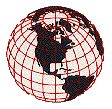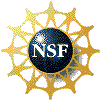THE
COCCIDIA OF THE WORLD
Compiled by
Donald W. Duszynski1, Steve J. Upton2 and Lee Couch1
1Department of Biology, University of New Mexico
2Division of Biology, Kansas State University
Comments: eimeria@unm.edu
(Duszynski),
lcouch@unm.edu (Couch)
 The protist phylum Apicomplexa
Levine, 1970 comprises a large and heterogeneous assemblage of obligate
intracellular parasites of medical and veterinary significance (e.g. Eimeria,
Cryptosporidium, Plasmodium, Toxoplasma). The largest subgroup of the
phylum is the suborder Eimeriorina Leger, 1911, which contains organisms
collectively referred to as the coccidia (Levine et al., 1980). Predominantly
intestinal parasites, coccidia infect most phyla of invertebrates and all
vertebrate classes. The disease they cause, coccidiosis, is recognized as the
major health hazard in domestic animal husbandry, in zoo environments, and in
wild animal populations when habitat is lost and overcrowding occurs. At
present, the Eimeriorina has 8-13 families, 36-39 genera and >2000 named
species. By far, the largest family in the suborder, Eimeriidae Minchin, 1903,
with 17 genera and ~1700 species (this database) is the group that we are
working to resolve on a global scale.
Working within the taxonomy of
the coccidia is difficult. (1) The literature is vast and widely scattered,
much of it appearing in obscure journals that have limited circulation. In
consequence, literally hundreds of species descriptions remain unarchived
and/or uncatalogued. The only definitive work on the group has been Pellérdy's Coccidia
and Coccidiosis (1974); although Levine (1988) authored a 2 volume
checklist, The Protozoan Phylum Apicomplexa, these volumes are useful as
lists, but are incomplete, not cross-referenced by host, parasite,
locality, author or any other way and, thus, have limited value. (2) The
coccidia have a complex life cycle that includes 3 sequential stages:
endogenous merogony and gamogony followed by sporogony which is exogenous. This
complexity resulted in various stages of the same coccidian species being
described as different species, or even placed in different higher taxa (genera
to suborders), before their basic life history was understood. (3) The
endogenous (intracellular) developmental stages in a coccidian life cycle are
unknown in >98% of all described species and are impossible to find or
identify under field conditions, so these characters have little present
taxonomic value. (4) The exogenous stage (oocyst), upon which the majority of
all species descriptions are based, is highly resistant to all known fixative
techniques and, to date, no satifactory method is known to permanently preserve
its structural features; thus, the taxonomy of coccidians has been
non-specimen-based. As a result, most species are described solely on
measurements of different structures in the sporulated oocyst, some additional
key qualitative features, and line drawings. Even though both the Botanical and
Bacteriological Codes accept line drawings as type specimens for organisms that
cannot be preserved, the Zoological Code has not yet addressed this issue
adequately.
These problems make sorting through the taxonomic
literature on this group difficult, and differentiating species can be
"best-guess" work even for an experienced taxonomist. Here we seek to
catalogue all known species of coccidia within the Eimeriidae and to reference
whatever information is available about each species, including, but not
limited to: current terminology and taxonomic status, including synonyms; type
host and other known hosts; type locality and geographic distribution;
descriptive parameters of all known life history stages, including line
drawings and photomicrographs (if any); pathology; unique biological details
that can help distinguish a species (e.g., prepatency, patency, ultrastructure,
excystation, cross-transmission studies, etc.); reference to gene sequences, if
available; kinds of type material archived and their museum location(s); and
complete or representative literature citations.
The protist phylum Apicomplexa
Levine, 1970 comprises a large and heterogeneous assemblage of obligate
intracellular parasites of medical and veterinary significance (e.g. Eimeria,
Cryptosporidium, Plasmodium, Toxoplasma). The largest subgroup of the
phylum is the suborder Eimeriorina Leger, 1911, which contains organisms
collectively referred to as the coccidia (Levine et al., 1980). Predominantly
intestinal parasites, coccidia infect most phyla of invertebrates and all
vertebrate classes. The disease they cause, coccidiosis, is recognized as the
major health hazard in domestic animal husbandry, in zoo environments, and in
wild animal populations when habitat is lost and overcrowding occurs. At
present, the Eimeriorina has 8-13 families, 36-39 genera and >2000 named
species. By far, the largest family in the suborder, Eimeriidae Minchin, 1903,
with 17 genera and ~1700 species (this database) is the group that we are
working to resolve on a global scale.
Working within the taxonomy of
the coccidia is difficult. (1) The literature is vast and widely scattered,
much of it appearing in obscure journals that have limited circulation. In
consequence, literally hundreds of species descriptions remain unarchived
and/or uncatalogued. The only definitive work on the group has been Pellérdy's Coccidia
and Coccidiosis (1974); although Levine (1988) authored a 2 volume
checklist, The Protozoan Phylum Apicomplexa, these volumes are useful as
lists, but are incomplete, not cross-referenced by host, parasite,
locality, author or any other way and, thus, have limited value. (2) The
coccidia have a complex life cycle that includes 3 sequential stages:
endogenous merogony and gamogony followed by sporogony which is exogenous. This
complexity resulted in various stages of the same coccidian species being
described as different species, or even placed in different higher taxa (genera
to suborders), before their basic life history was understood. (3) The
endogenous (intracellular) developmental stages in a coccidian life cycle are
unknown in >98% of all described species and are impossible to find or
identify under field conditions, so these characters have little present
taxonomic value. (4) The exogenous stage (oocyst), upon which the majority of
all species descriptions are based, is highly resistant to all known fixative
techniques and, to date, no satifactory method is known to permanently preserve
its structural features; thus, the taxonomy of coccidians has been
non-specimen-based. As a result, most species are described solely on
measurements of different structures in the sporulated oocyst, some additional
key qualitative features, and line drawings. Even though both the Botanical and
Bacteriological Codes accept line drawings as type specimens for organisms that
cannot be preserved, the Zoological Code has not yet addressed this issue
adequately.
These problems make sorting through the taxonomic
literature on this group difficult, and differentiating species can be
"best-guess" work even for an experienced taxonomist. Here we seek to
catalogue all known species of coccidia within the Eimeriidae and to reference
whatever information is available about each species, including, but not
limited to: current terminology and taxonomic status, including synonyms; type
host and other known hosts; type locality and geographic distribution;
descriptive parameters of all known life history stages, including line
drawings and photomicrographs (if any); pathology; unique biological details
that can help distinguish a species (e.g., prepatency, patency, ultrastructure,
excystation, cross-transmission studies, etc.); reference to gene sequences, if
available; kinds of type material archived and their museum location(s); and
complete or representative literature citations.
Accessing the Database and Additional Web Resources:
 The Coccidia of Snakes of the World
The Coccidia of Snakes of the World
 Biology of the Eimeriidae
Biology of the Eimeriidae
 Techniques for the
Preservation of Life Cycle Stages
Techniques for the
Preservation of Life Cycle Stages
 Alphabetical List of the Coccidia
Alphabetical List of the Coccidia
 COCCIDIA OF THE WORLD Database
COCCIDIA OF THE WORLD Database
 Coccidiologists of the World
Coccidiologists of the World
 Coccidiosis Conferences (2008-2014) with some Powerpoint Presentations
Coccidiosis Conferences (2008-2014) with some Powerpoint Presentations
 Molecular Sequences in the NCBI GenBank Database
Molecular Sequences in the NCBI GenBank Database
 Links to Other Parasitology-related Sites
Links to Other Parasitology-related Sites
 The Microbiology Information Portal
The Microbiology Information Portal
 Acknowledgments
Acknowledgments
 In 1994, the National Science
Foundation announced a Special Competition, termed Partnership for Enhancing
Expertise in Taxonomy (PEET), that was initieated to train the next generation
of taxonomists of poorly studied groups, mostly microorgansims. In 1995, the
first cohort of 21 awards was made, including DEB 9521687, which initiated the
"Coccidia of the World" project. This endeavor, a joint effort
between the University of New Mexico and Kansas State University, began the
task of creating a database for the scientific community that, eventually,
would catalogue all known species of coccidia (Apicomplexa: Eimeriidae), their
descriptions, and all biologically relevant material.
In 1994, the National Science
Foundation announced a Special Competition, termed Partnership for Enhancing
Expertise in Taxonomy (PEET), that was initieated to train the next generation
of taxonomists of poorly studied groups, mostly microorgansims. In 1995, the
first cohort of 21 awards was made, including DEB 9521687, which initiated the
"Coccidia of the World" project. This endeavor, a joint effort
between the University of New Mexico and Kansas State University, began the
task of creating a database for the scientific community that, eventually,
would catalogue all known species of coccidia (Apicomplexa: Eimeriidae), their
descriptions, and all biologically relevant material.
NSF-PEET and DEB 9521687-Related Resources
 DEB 9521687 PEET Products
DEB 9521687 PEET Products
Publications
Presentations and
Posters
Student Training
 Ongoing Projects/Research
Beyond DEB 9521687
Ongoing Projects/Research
Beyond DEB 9521687
![]() The Coccidia of Snakes of the World
The Coccidia of Snakes of the World![]() Techniques for the
Preservation of Life Cycle Stages
Techniques for the
Preservation of Life Cycle Stages ![]() Alphabetical List of the Coccidia
Alphabetical List of the Coccidia ![]() COCCIDIA OF THE WORLD Database
COCCIDIA OF THE WORLD Database![]() Coccidiosis Conferences (2008-2014) with some Powerpoint Presentations
Coccidiosis Conferences (2008-2014) with some Powerpoint Presentations![]() Molecular Sequences in the NCBI GenBank Database
Molecular Sequences in the NCBI GenBank Database![]() Links to Other Parasitology-related Sites
Links to Other Parasitology-related Sites![]() The Microbiology Information Portal
The Microbiology Information Portal![]() DEB 9521687 PEET Products
DEB 9521687 PEET Products![]() Ongoing Projects/Research
Beyond DEB 9521687
Ongoing Projects/Research
Beyond DEB 9521687